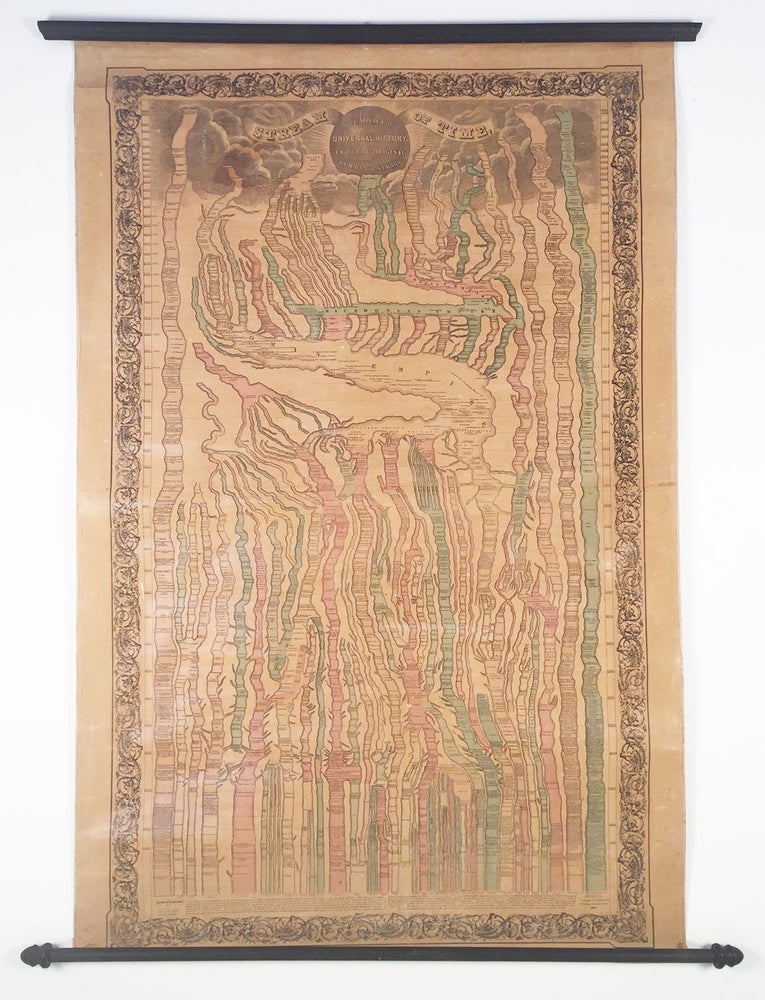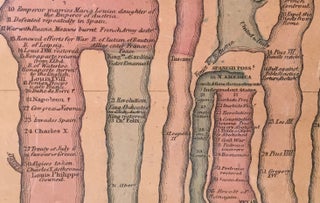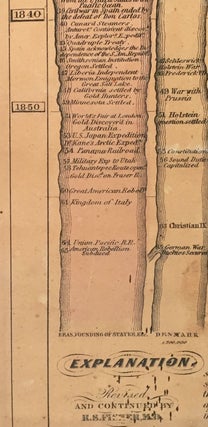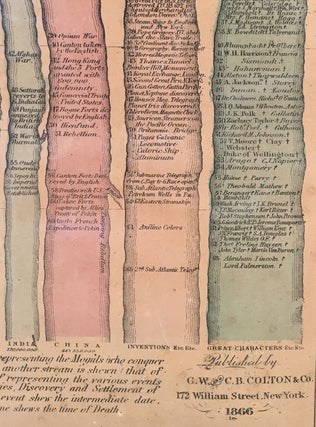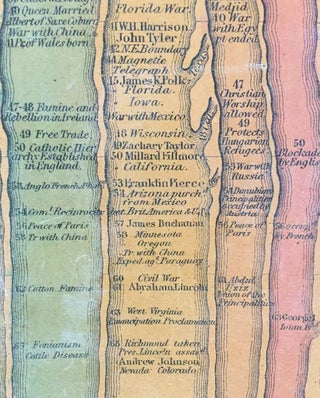Stream of Time, Or Chart of Universal History, From the Original German of Strass.
New York, NY: G.W. & C.B. Colton & Co., 1866. Hand-colored lithograph mounted on original linen and affixed to wooden rods, linen selvage, 48.75" x 29.75" plus margins. An unrecorded American edition of Friedrich Strass’s Strom der Zeiten, an extraordinary chart depicting history as a great system of streams and lakes. This is the 1866 Colton edition of Strass’s influential chart, updated to 1865, including such events as the fall of Richmond, Virginia and the assassination of Abraham Lincoln. Strass depicts history as a great flood of intermingling streams springing from storm clouds at the top and flowing to the bottom of the sheet. The map commences with nine streams, "Jews," "Egyptians," "Phoenicians," "Syrians," "Assyrians," etc. and ends with 37 individual streams, all featuring events in the history of the nation represented and the populations of each at the time of publication. The explanation at the bottom of the chart reads: “Each Nation is represented by a stream, which is broken in upon or flows on undisturbed as it is influenced by the accession of Territory or the remaining at Peace." The smaller streams attached to the sides of larger steams show, by flowing upwards, conquests; downwards, losses. Lines running horizontally across the chart represent centuries, which are enumerated in the left and right margins; events are accorded a number to correspond with this temporal grid. Numbers affixed to each person or event indicate the intermediate date. Not all of the streams depicted represent nations or peoples. The leftmost stream is entitled, "Eras, Founding of Cities, Discovery and Settlement of Countries &c."; some of the important events exhibited here include, "Bonaparte cr'd Emperor of France" (1804), "Declaration of Independence" (1776), etc. The two streams pictured farthest to the right represent: i) "Inventions Discoveries Remarkable Events," starting with the "creation of the world"; and ii) "Great Characters &c," beginning with Adam and Eve and Cain, and featuring figures such as Schiller, Joan of Arc, Dante, et al. Well before 500 A.M., four new streams have entered the fray and many of the existing ones have already been terminated, frayed, or swallowed up into other streams. Around 150 A.M., the Germans appear ex nihilo; and circa 200 A.D., the vast majority of streams empty into the Roman Empire, which—after about 600 years—begins to break down into various sizable streams, such as the “Western Empire” (encompassing Spain and Italy), Britain, "Eastern Empire," etc. The Roman Empire figures as the largest lake, while the least broken-up stream is that of the China, which experiences incursions by the Moguls between 1200–1300. “English Colonies Settled” occurs in “[160]7 Jamestown Virginia,” and thus begins the stream of American history, the final entry for which reads “[18]65 Richmond taken. Pres. Lincoln assas.d. Andrew Jackson. Nevada, Colorado.” Following its first publication in 1804, Strom der Zeiten was translated into many languages. Strass's map bears the influence of the English natural philosopher Joseph Priestly who prized the graphic depiction of history over its annalistic representation. However, Strass would depart from the uniform, homogeneous chronology Priestly purveyed, instead opting for a graphic representation of history as agonistic. As Rosenberg and Grafton write with regard to this map, "events ebb and flow, fork and twist, run and roll and thunder.” Strass's chart would prove to be seminal. To give one notable example, its influence is evident in the pictorial maps of the eminent American women's rights activist and educator Emma Willard (1787–1870); in particular, her 1835 "Picture of Nations or Perspective Sketch of the Course of Empire," which can be viewed here, at ScienceDirect. Willard's map embraces Strass's presentation of history for the purposes of her own pedagogy. J. H. Colton published editions of The Stream of Time in 1842 and 1845, as well as an edition revised by R. S. Fisher in 1860. OCLC records one copy each of these. This 1866 edition, published by G.W. & C.B. Colton, is further revised and includes references to the Abraham Lincoln, the Civil War, the Emancipation Proclamation, the Union Pacific Railroad (1864), and the second trans-Atlantic cable (1865). No copies are recorded in OCLC or Antique Map Price Record, nor does a google search yield any. A fascinating and influential representation of world history. REFERENCES: Grafton, Anthony and Rosenberg, Daniel. Cartographies of Time: A History of the Timeline, Princeton: Princeton Architectural Press, 2010, pp. 143, 144–45, 147. Schulten, Susan. Mapping The Nation, Chicago: University of Chicago Press, 2012, pp. 31–33. Schulten, Susan. Emma Willard and the Graphic Foundations of American History, at sciencedirect.com CONDITION: Very good, half inch split in sky at upper left, a minor spots.
Item #4271
Sold


